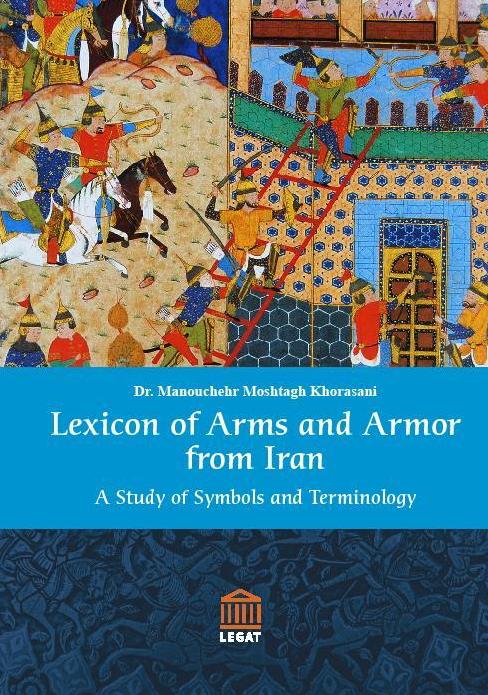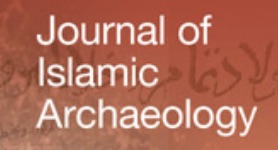The below article by Dr. Manoucher M. Khorasani was published in the Journal of Islamic Archaeology, Volume 4 (No.2), pp.261-266, 2017. The article provides a critical examination of Filiz Çakır Phillip’s assertions with respect to Iranian striking and thrusting weapons of the 15th to 19th centuries.
======================================================================================
Iranische Hieb-, Stich- und Schutzwaffen des 15.–19. Jahrhunderts (Iranian striking and thrusting weapons and armor from the 15th–19th centuries) by Filiz Çakır Phillip. De Gruyter, 2016. 382pp. Hb. $140.00, ISBN-13: 978-3110318135.
Reviewed by Manouchehr Moshtagh Khorasani, M.Khorasani Consulting, [email protected]
This book attempts to describe Iranian arms and armor from the 15–19th centuries by concentrating on a few collections of historical weapons from museums and private collections outside Iran. This is an odd approach since it neglects the royal collection of Iranian arms and armor, formerly the collection of Nassereldin Shah Qajar, now on display on three Iranian museums in Tehran, Shiraz and Bandar Anzali. Instead Çakır Phillip looks at a limited selection of arms and armor in the inventories of the following collections: a) Museum für Islamische Kunst, Berlin mostly based on private collec-tion of Friedrich Sarre (ca. 40 items); b) Deutsches Historisches Museum (Zeughaus), Berlin, and c) the Ottoman arsenal and the collections of Topkapi Sarayi Müzesi and Askeri Müze in Istanbul. Çakır Phillip opines that the collections of the two Turkish museums are among the world’s oldest and richest collections of Islamic weapons. She states that the Ottoman main arsenal stems from the 15th century and can be documented by historical documents. Another part of the collection comprises historical weapons which were obtained as war booty, among them there are Arabic, Mamluk, Iranian and Turkmen pieces. The book attempts to describe how Iranian weapons were constructed and worked. However, due to a lack of knowledge about the means of their production, some explanations are not accurate. Referring to Sasanid helmets, Çakır Phillip states that spangenhelm left the face of the wearer bare. Although some Sassanid helmets did leave the face exposed, there are also Sassanid helmets of spangenhelm construction with a face mask made of mail as also there are examples with an iron face mask.
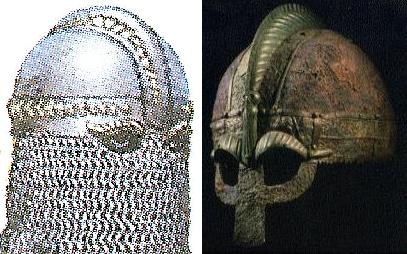
Viking Helmet (Right; Picture Source: English Monarchs) and reconstruction of earlier Sassanian helmet at Taghe Bostan, Kermanshah, Iran (Left; Picture Source: Close up of Angus Mcbride painting of Sassanian knight at Taghe Bostan, Wilcox, P. (1999). Rome’s Enemies: Parthians and Sasanid Persians. Osprey Publishing, p.47, Plate H1).
The author states that she did not take shields into consideration since they were only used defensively. However, Persian shields were used both defensively and offensively as in most systems of sword and shield combinations, where the shield is used both as an offensive and defensive weapon. In explaining the so-called Turban helmet or Turkmen helmet, Çakır Phillip claims that after the Mongol invasion and rule, weapons and armor were developed to have a higher functionality. This is a bold statement as weapons in the region before the Mongol invasion were already highly developed and there is no evidence that such an invasion led to a higher functionality, nor does Çakır Phillip provide any for her statement.
Although the term kolāhxud (Phillip’s spelling kulah khud) is a general term in Persian, Çakır Phillip uses the term to refer to a specific type of Persian helmet made with a round dome, a nasal and aventail of mail. She contrasts this to the shape of a turban helmet. An analysis of Persian manuscripts would have shown the author that the term kolāhkhud was not only used in the Qajar-period manuscripts such as Rostam al Tavārix justifying the use of the term for late Safavid period as a successor of the turban helmet, but it had been already in use in much earlier periods. Regarding the mail aventail of the kolāhxud, Çakır Phillip assumes that the mail rings are riveted and small “aus kleinen genieteten Stahlringen” and adds that the more complex one, the rings have “einen zusätzlichen Mittelsteg in jedem einzelnen Ring”, possibly she means that the rings are “theta-shaped (θ)” which is the technical term for this type of rings. Surprisingly, she claims that the poor aventails are of machine made wire and are products of the 20th century, possibly referring to butted mail. However, it should be noted that butted mail rings do not necessarily imply that a) they are from the 20th century as there are many dated and documented mail armors with butted rings dating from much earlier periods and b) butted mail rings do not mean necessarily that the armor was a show item. Japanese armor has arm protectors which were made of butted rings, which had been hardened to increase their strength.
Regarding feather holders, jā pari, Çakır Phillip states that the number feather holders on Iranian kolāhxud vary between two and three, of which she claims the variation with three feather holders is a fashion of the 18th century without providing any references. She also claims that the use of peacock feathers on the helmet is an Indian influence, since the Rajputs adored peacocks, ignoring that peacocks had always played an important role in Persian culture as well.
In the case of body armor, Çakır Phillip claims that the Central Asian warriors used two types of armor: “soft” armor and “hard” armor and adds that the soft armor was made of leather, raw silk and hemp whereas the hard armor was made of iron plates and mail armor. She also opines that using the combination of both, one could create scale and lamellar armor as well as brigandine. However, this explanation is very misleading. Calling leather armor soft is absolutely wrong. Lamellar or even laminar armor made of leather were multi-layered and hardened, fully capable of absorbing the shock of enemy’s weapons and even arrow shots. She also wrongly assumes that the term jošan (ğūšan) defines “plate and mail armor”. However, mail armor in Persian is called zereh. She simply quotes Zeller and Rohrer on this and says that mail armor is called ğūšan in Persian and zirh and sābiġa in Arabic. Cursory research in Persian manuscripts would have been enough to see this is a wrong assumption. The term zereh is already mentioned as early as the Šāhnāme and a number of other Persian manuscripts to refer to mail armor such as Tārix-e Beihaqi, ĀlamĀrāyeŠāh Tahmāsp, etc. Actually the origins of the term zereh go back to the Middle Persian term zrēh or zarēh see Kārnāme-ye Ardešir Bābakān.
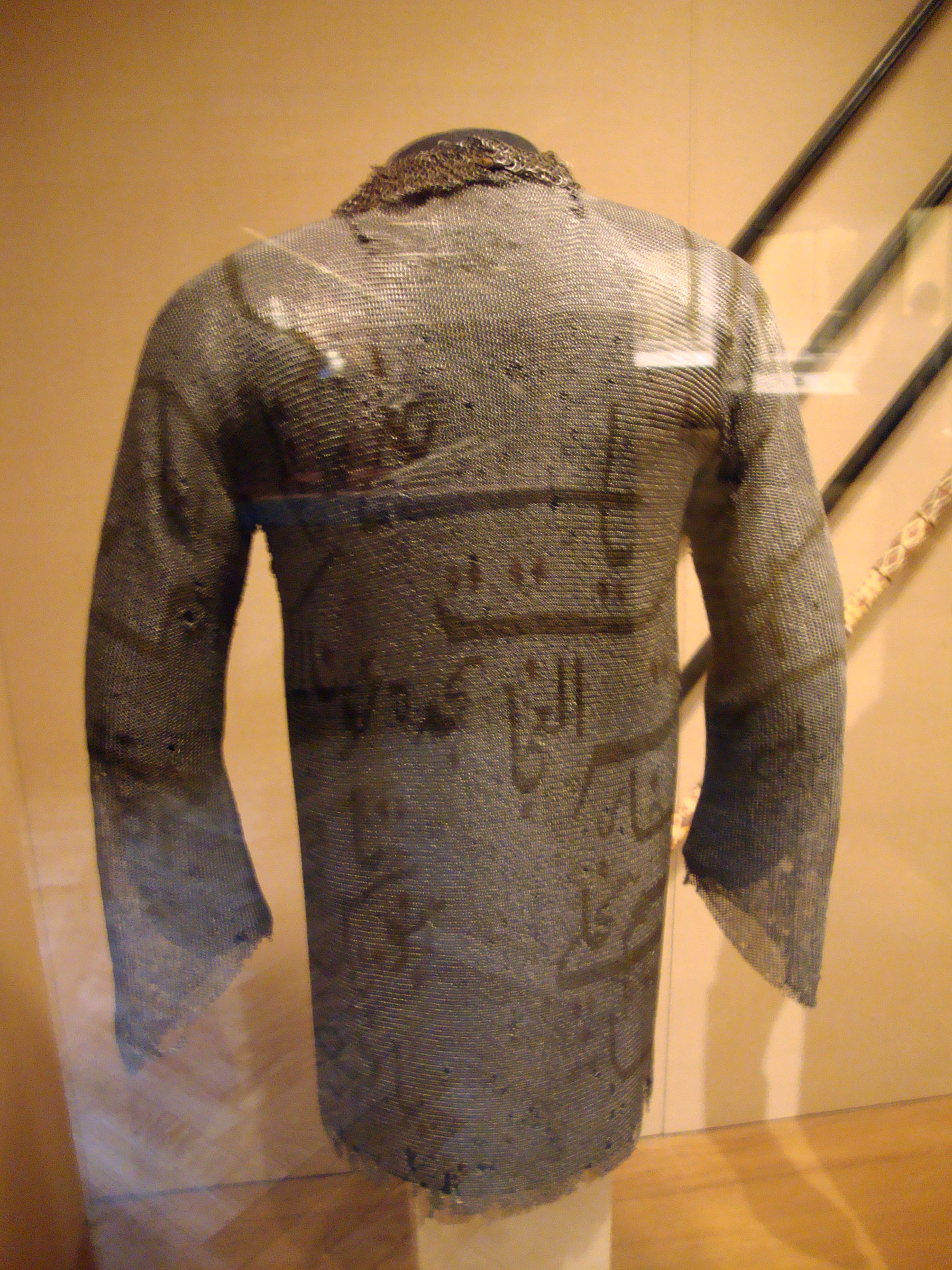
Persian mail armor dated to 1816-1817, housed at the New York Metropolitan Museum of Art (Accession Number: 36.25.57; Source: “greyloch” in Public Domain).
Çakır Phillip states that there were also mail armors made of solid rings and riveted rings put together alternately. She suggests that the solid rings were there to strengthen the mail armor against the thrusts of the enemy’s weapon. However, the major reason for alternating rows of solid with riveted rings was to make the production of mail easier and faster. Further, she repeats a misconception that mail armor was only designed to protect against cuts and a thrusting weapon could have separated the riveted rings. However, recent trials on mail armor with riveted rings worn over multi-layered gambeson show that piercing even a stationery target wearing such a combination is not easy, even less so against a moving target. Breaking a riveted ring using a weapon is difficult. This misconception about mail armor was prevalent among some early researchers. She also states that there were different types of mail armor, but the majority of them were worn over the head. However, the majority of Iranian mail armor had an opening in front which was held closed with hooks or buckles.
Further in her classification of Persian armor, Çakır Phillip identifies lamellar armor “Lamellenpanzer” and claims that it was also known as ğūšan (jošan). This is an incorrect statement as I have shown above (see zereh). Regarding jošan, she states that the lamellar armor was made of different lamellar plates made of leather, horn or metal, directly connected to each other and she claims that making lamellar armor was cheaper than the mail armor. This statement is not backed up and we know today through experimentation that making good lamellar armor is just as time-consuming and expensive as making mail armor. Çakır Phillip states that during the Il-Khanid period, lamellar armor was the standard armor. However, during that period lami-nated banded armor was more widespread than lamellar armor. We should note that the term jošan can be found in many Persian manuscripts. However, different Persian manuscripts provide different explanations for this type of armor and it is not clear what kind of armor the term jošan actually describes. According to the Digital Lexicon of Dehkhoda, jŏšan is a type of mail-and-plate armor and is similar to tanure since both are made from mail and iron plates; however, the iron plates (qeibe) of a jŏšan are smaller than those used in the tanure.
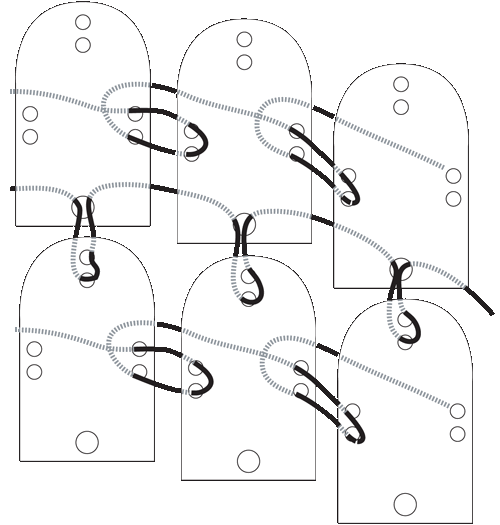
Illustration by Trent Fehr of how lamellar armor is laced together (Source: Public Domain).
In her next classification of armor, Çakır Phillip puts three types of armor in one category “Schuppenpanzer, Lamellenpanzer und Brigantine” (scale armor, lamellar armor and brigandine).. She defines scale armor as made of different plates sewn to a leather or fabric shirt vertically. She describes this type of armor as bagtar. Pos-sibly she made a mistake in mentioning lamellar armor in this category again as she does not specify it here. Instead, she describes brigandine as kažāġand and says that it was mentioned by al-Tarsūsi. Surprisingly, although Çakır Phillip provides the explanation by Usamah Ibn-Munquidh on the nature of kažāġand (who describes it as a mail shirt with integral padding and an exterior cover). Nicolle rightly explains that jazerant or jazrain stems from the Persian word kazaqand and means a mail shirt (haubergeon) with integral padding plus a fabric-covered exterior. Although, the Dig-ital Lexicon of Dehkhoda explains qazāgand as a padding worn under the armor, this explanation cannot be right and as qazāgand is armor in its own right. It consists of mail armor sandwiched between two layers of light padding. Usamah Ibn-Munquidh describes a particularly heavy version made with two layers of mail. In Europe, this armor was called a jazerant and Blair suggested that the word is a derivative of qazāgand. In the Farhang-e Nafisi, Nafisi provides two meanings for qazāgand: a) a cloth that is filled with wool and silk and worn in the battle and b) a type of mail armor. In contrast to the explanation of Çakır Phillip, qazāgand cannot be compared to a European brigandine, which is a body armor made of a fabric garment, which is generally canvas or leather, lined with small oblong steel plates riveted to inside.
Çakır Phillip distinguishes another type of armor which she describes as “mail armor combined with plate armor” (Kettenpanzer mit Plattenpanzer kombiniert). She differentiates between two types: a) The first type comprises rectangular plates protecting the belly, sides and back leaving the shoulders to be protected by mail armor. She says that this type can be described as either jŏšan (ğūšan) or zirh-i čūgāl but rejects the use of both terms as she says that they are general terms. She stresses that in Turkish čūgāl is a general term signifying any type of armor be it mail armor or plate armor for humans or animals, but fails to realize that jŏšan actually is used to describe this type of armor in Persian manuscripts. Çakır Phillip describes the second type as a type of armor which has two round plates one in front and one in the back combined with mail and other plates. Possibly she is referring to the Ottoman krug armor.
The next armor type identified by Çakır Phillip is čāhrāyne (čahārāyina). She rightly identifies different parts of a čāhrāyne as the front plate “sineband “ (sīnaband), the back plate “poštband “ (puštband) and the side plates “baqalband “ (baġalband).
In the chapter on cut and thrust weapons (Hieb- und Stichwaffen), Çakır Phillip claims that swords and sabers remained the most important weapons until the introduction of firearms due to their cutting and thrusting capabilities. However, in Persian armies similar to other armies, bows, lances and spears played the primary role and swords played a secondary role. This was due to different factors: a) spears and lances and of course bows had a wider range, b) it was easier to teach inexperienced troops how to wield a spear rather than a sword and c) it was cheaper to produce a spears compared to forging a sword. Further, Çakır Phillip claims that akenakes was the sword of Persian, however, its shape is not clear. This is not correct as much research has been done on the Persian and Median akenakes. Surprisingly, Çakır Phillip claims that Latin translations from Medieval era associate the term with simiterra (scimitar) and adds that in the 3th century the straight sword of the Greeks found its way among the Sassanids! This is incorrect as the predecessors of Sassanids, the Parthians, already used double-edged long straight swords and Achaemenid short sword akenakes was also a short straight sword.
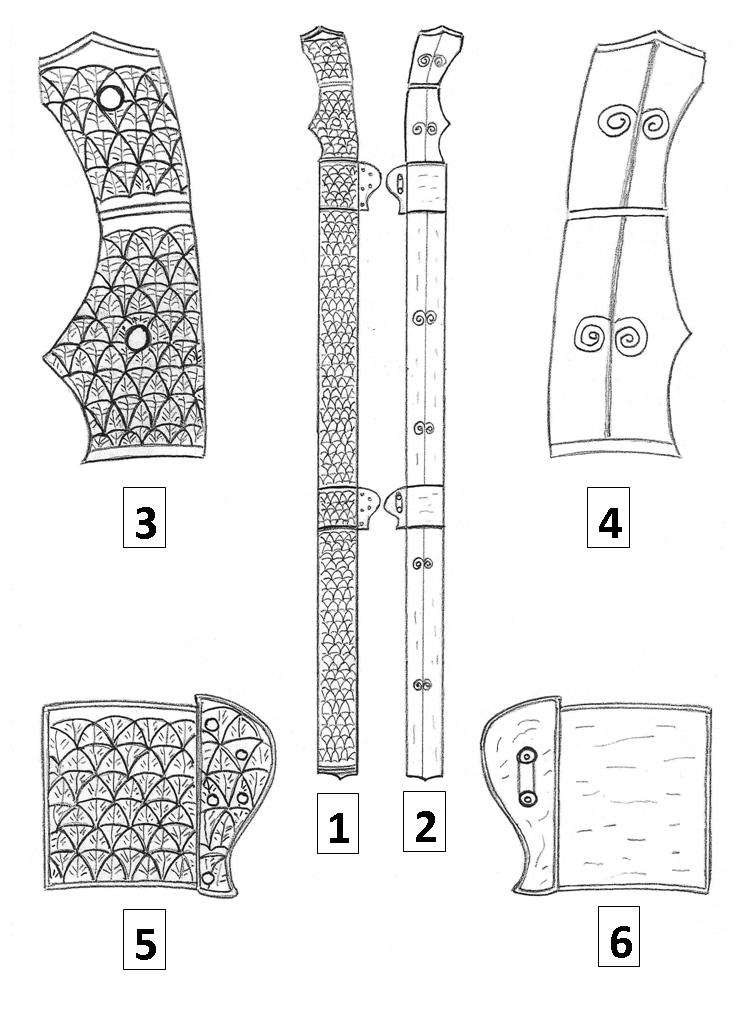
Late Sassanian sword (Farrokh 2004; reprinted Hughes 2010, p.51). Entire sword from front Regarding different types of Oriental sabers, Çakır Phillip distinguishes between three types: the Ottoman kılıç , Persian šamšr and Indian talwar. Two questions arise here: a) First, why does Çakır Phillip mention kiliç and talwar in a book dedicated to the study of Iranian arms and armor? and b) she still wrongly believes that Persian šamšr denotes a classical type of Persian saber with a high curve and wedged-cross-sectioned blade known in the West under this term. This, however, was a Western misconception widespread among collectors of arms and armor for several years. Unfortunately, Çakır Phillip repeats the same misconception in 2016. Prior to the Arab Conquest of Iran and the introduction of Islam in 631 A.D., all swords used in Iran were straight-bladed. This indicates that the preceding Persian dynasties, the Achaemenians, Parthians, and Sassanians all used swords with straight blades. Although the term šamšir was used in English and other European languages to refer to the classical Persian šamšir with its high degree of curvature, it refers to any type of sword, regardless of its shape, in the Persian language. The origin of this term can be seen in the Middle Persian Pahlavi, in which it was called šamšēr, šafšēr and šufšēr. Further, Çakır Phillip assumes that the highly curved šamšir was used as a symbol of ruler’s legitimacy. She claims that this type of saber replaced all other types of early sabers and swords and that there was a revival of using earlier forms only in the 19th century. However, straight swords had always been produced next to the highly curved swords so it was not a revival. She assumes the Indian talwar had a ricasso contrary to Iranian šamšir and that only Indian talwars were also decorated with chiseling and enameling next to gold-inlaying and -overlaying. However, there are Indian talwar blades without a ricasso and there are Iranian šamšir decorated with chiseling and even enamelling. Suprisingly, Çakır Phillip claims that the late renditions of zulfiqar were completely useless in fighting. This is an unsupportable generalization, when applied to all blades of this type. There are examples made of very sharp crucible steel blades, which cut very well. A 19th century curved sword from Iran (Source: M. Khorasani Consulting). It was acquired in 1931 and was formerly held in the collection of Count Sergey Sheremekev’s collection. The present work was published in 2016 but it does not take into consideration that by 2010, many Persian manuscripts on crucible steel production and sword classification were introduced and analyzed in the books Lexicon of Arms and Armor from Iran: A Study of Symbols and Terminology and the very fact that the book was a doctorate thesis submitted to the Department of Humantities and Culture (Fachbereich Geschichts und Kulturwissenschaften) of the Freien Universität Berlin in 2011, it is not clear why the author decided to rely this part of her thesis solely on older publications which are prevalent in many collectors’ books on historical arms and armor. In the abovementioned book, the following Persian manuscripts on steel production and sword classification are mentioned: Nŏruznāme [The Book of Nŏruz] attributed to Omar ibn Ebrāhim Khayyām-e Neyšāburi, Javāhernāme-ye Nezāmi [Nezāmi’s Book of Precious Stones] by Mohammad ibn Abi al-Barakāt Jŏhari Nezāmi, Bayān al-Sanā’āt[Description of Crafts] by Hobeyš ibn Ebrāhim ibn Mohammad Taflisi, Ādāb al-Harb va al-Šojā-e [Customs of War and Bravery] by Mohammad ibn Mansur ibn Said Mobārak Šāh Fakhr-e Modabbar, Tansukhnāme [The Book of Minerals] by Khāje Nasireldin Tusi, Arāyes al-Javāher by Abolqāsem Kāši, Gŏharnāme [The Book of Jewels] written by Mohammad ibn Mansur, and Ta’id Besārat [Aid to Sight] by Mirzā Lotfallāh. Instead of mentioning the Persian manuscripts on steel production and sword classification, Çakır Phillip relies entirely on two early manuscripts on steel production and swords written in Arabic, one by the Arab scholar al-Kindi, On Swords and their Kinds, and the other written by the Iranian scholar Abu Reihān Beiruni titled Al-Jamāhir fi Marefat al-Jawāher [The Sum of Knowledge about Precious Stones]. Çakır Phillip spells pulād-e gohardār as pūlād-i ğūhārdār or fūlād-i ğūhārdār and pro-vides the translation “glänzender, wohltemperierter Stahl” (shining, well tempered steel). However, the real spelling in Persian is gohar and not ğūhār. The true transla-tion of is “bejeweled steel” as gohar means “jewel” in Persian and in figurative sense it can be translated as “watered steel”. She claims that for the production of crucible steel in Iran, wootz steel from Sri Lanka was imported. However, there are accounts that Iranian smiths bought crucible steel cakes and bars imported from India (see Biswas and Floor), local steel, Khorasan damask and Qazwin damask, was also made and brought to Isfahan. Recently, archaeological evidence on the existence of cru-cible steel production in Iran has also been found (see Emami and Karamad). Relying solely on western publications, Çakır Phillip distinguishes between the following patterns of Persian crucible steel: striped damask (sham), water damask, wavy damask, network damask (divided in two types of karakhorasan and karatābān) and ladder damask. A cursory study of Persian texts of the Qajar period would have revealed to the author the real spelling of some of these terms: Çakır Phillip spells “black Khorasan” pattern as karakhorasani actually qaraxorāsāni; “black taban” as karatābān actually either taban or qarataban. Later she has the “ladder pattern” as kirkmerdiven instead of qerq nardebān. Further research in Iranian manuscripts on crucible steel production would have revealed that they describe a variety of cru-cible steel patterns (e.g. the Nŏruznāme [Book of Nowruz] which differentiates the following patterns: kalāqi, crow-like; gŏhar-e hamvār, even pattern; etc.). The merit of the book is that it emphasizes the importance of Persian culture and its influence on other neighboring cultures. In this respect, Çakır Phillip explains that the Abbasid scholars derived new impulses from the Sassanid culture as the Iranian legacy was especially strong in Baghdad.
